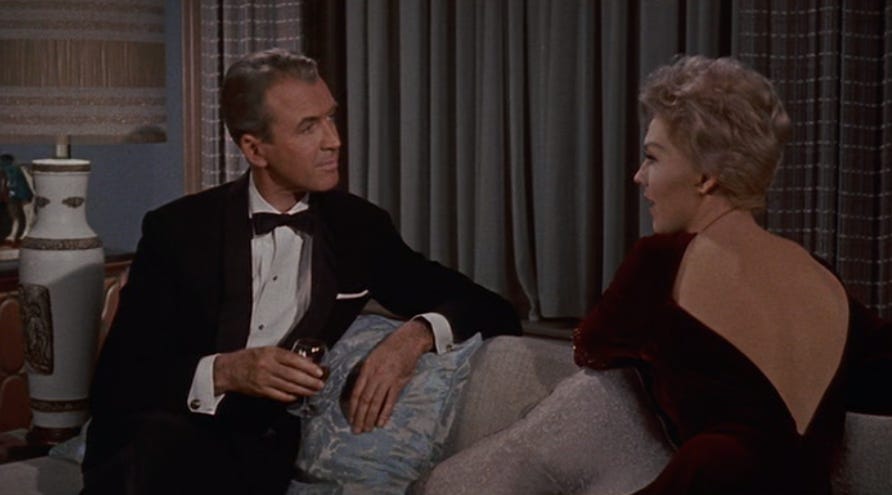The Other Jimmy Stewart Christmas Movie
When Hollywood's Golden Boy Got Hip about the Holidays with Bell, Book, and Candle
By 1958, Jimmy Stewart was mastering a complex transition that few Golden Age stars managed to navigate, though many had tried. While George Bailey would eventually charm millions of TV viewers every Christmas starting in the early seventies, It's a Wonderful Life (1946) wasn't the only festive trick Jimmy had up his sleeve. The post-war forties had come and gone but now it was the late-fifties and audiences were starved for something hip … something fresh. And it would be a world away from the Gower’s Drug Store soda fountain or the white picket fences of Bedford Falls.
This was the perfect time for Bell, Book, and Candle, a spellbinding cultural cocktail set in Greenwich Village, which caught fifty-year-old Jimmy at his most experimental. Entering a different phase of life with multiple Hitchcock and Western films behind him, he was no longer the fresh-faced boy next door or even the cynical Peeping Tom of Rear Window (1954). Regardless of age, Jimmy was about to redefine what a Hollywood leading man could be.
The timing couldn't have been more intriguing. Jimmy and Kim Novak had just wrapped filming on Hitchcock’s Vertigo (a film, like It’s a Wonderful Life that wasn’t appreciated in its time, but would be considered a masterclass in genius Hitchcock filmography years later.) Much of the reason for its initial failure was that it challenged audiences with psychological twists that confused many and required more than one viewing. Secondly, it upended Jimmy's wholesome image. Now Columbia was orchestrating a reunion, but with a holiday twist that nobody saw coming.
The late fifties were a bewildering time of earth-shattering shifts in Hollywood. The studios were doing everything in their power to battle the television invasion, method acting revolutionized the naturalism of on-screen acting, and executives were throwing everything at the wall to see what would stick. From wide screens, and 3-D pictures, to biblical epics, no ideas were off limits if they maintained lines at the ticket booth.
And so into this identity crisis arrived Bell, Book, and Candle, about a West Village witch who literally enchants a straight-laced publisher with a love spell, essentially creating the template for 1964’s Bewitched series before Samantha Stephens had even dreamt of wiggling her nose.
Jimmy, ever the craftsman, was doing some of his most interesting work. He'd already survived his bomber pilot days of World War II, the forties McCarthy-era Communist era that turned the industry on its head, and no one knew who to trust. All this, and he’d managed to crystalize a career for himself that arguably outshone even his pre-war days of The Philadelphia Story (1940) and Mr. Smith Goes to Washington (1939). Now he was pioneering a new kind of leading man – experienced, complex, and unafraid to play with his established persona.
While the real Greenwich Village of 1958 was home to struggling poets and revolutionary artists, Bell, Book, and Candle offers a more enchanted, matinee-friendly version of Manhattan's bohemian world. But watching Jimmy's publisher navigate this world is a tour de force in character development. Shep Henderson brings a worldly skepticism that's light years from George Bailey's small-town naivety.
Director Richard Quine, one of Columbia's most reliable craftsmen, brought a light touch that let the film's cultural commentary slip in under the radar. He created a world where magic and New York sophistication blended, while giving his stars room to create genuine chemistry.
Kim Novak, fresh from her impressive dual performance in Vertigo, brings layers of complexity to the witch, Gillian Holroyd. As a woman, she struggles with power, independence, and the price of conformity – themes that would explode into the cultural consciousness of the sixties. This is Kim at her most nuanced, delivering a performance that critics of the era underestimated. (Variety oddly stated that “with Kim Novak, the picture lacks the spontaneity and sparkle.”)
Jack Lemmon and Ernie Kovacs round out the cast as leading men of Hollywood's future. Jack was on the verge of redefining American film comedy with Billy Wilder’s Some Like It Hot (1959), while Ernie was already television's greatest innovator. Their presence makes the film feel like a bridge between eras, which is exactly what it was.
The holiday warmth cleverly balances out the modern edge. While It's a Wonderful Life celebrated traditional values and divine intervention, Bell, Book and Candle suggested that a little unconventional witchcraft was exactly what post-war America needed. The cultural revolution of the sixties was just around the corner, and somehow this sophisticated comedy sensed it coming.
Jimmy would soon focus primarily on the Western genre, but Bell, Book and Candle captures a unique moment when one of Hollywood's greatest legends was engaging with the cultural shifts happening around him.
Today, while It's a Wonderful Life remains the ultimate holiday tradition, Bell, Book and Candle also offers a fascinating alternate vision of Christmas cinema. It's a festive portrait of Hollywood in transition, disguised, of course as a supernatural rom-com. Jimmy's performance represents an evolution of his craft and an acknowledgment that American culture was transforming before everyone’s eyes. George Bailey needed divine intervention to appreciate his life, but Shep Henderson needed a witch to show him a new way of living. Both journeys are magic – just of very different kinds.
Perhaps that's why Jimmy Stewart remains our eternal Christmas everyman. No other actor in Hollywood history has managed to capture the holiday spirit in quite the same way – that unique blend of vulnerability and optimism that defines the season. In George Bailey, he gave us the gift of redemption; in Shep Henderson, he offered the possibility of transformation.
Together, these performances bookmark something essential about Christmas itself: that moment when we all stand suspended between tradition of the past and possibility of the future. Jimmy understood this space better than anyone else.
.






